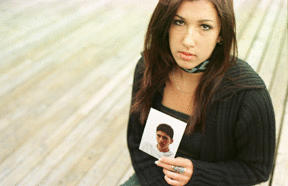Meghan Manheim always carries a special cache of yellow cards.
On one side are the words “This card is a cry for help!” and on the other, “This ribbon is a lifeline.”
The card is part of the Yellow Ribbon suicide prevention program that freshman Manheim and her parents have brought to Bainbridge High School.
Manheim hopes the program will steer teens toward a path different than that chosen by her brother Garth, who last July 11, at age 16, died by his own hand.
“Many people who commit suicide do not see how many people care for them until it is too late,” Manheim said. “Unfortunately, that was the case for my brother…and we never saw it coming.”
Garth was an accomplished student, tennis player and writer, according to his parents, Jonathan and Leigh Manheim.
Despite the perfectionism he sometimes turned on himself, and a tendency to contain his own feelings, he was not an obvious candidate for suicide, the family says. They consider the “why” of his decision to take his own life still unexplained.
Garth’s death was a bitter blow for the family, including Meghan and her 12-year-old sister Alana.
“It completely changed everything overnight,” Meghan said. “Nothing was the same.”
Her mother’s grief was compounded by the fact that Garth was the fourth person in her family line to commit suicide.
“It’s the thing you fear most, as a parent,” Leigh Manheim said. “I said I’d never survive it – but you do. And we’ve had so much support from the schools and from the community as a whole. Bainbridge is incredible.”
Yellow ribbons
The Manheims resolved to channel their grief into helping others, by bringing the Yellow Ribbon program to the high school.
The national program was founded in 1994 by the parents and friends of a teen who committed suicide.
Yellow Ribbon addresses myths about suicide and suggests ways to react when someone threatens self-harm.
The organization provides suicide prevention education in various forms, including: training manuals, brochures and other literature; speakers and people trained to lead workshops and seminars.
Yellow Ribbon also prints cards that ask for help when a teen can’t speak up.
The card lists a hotline number and advice for the person to whom the young person hands the card:
“Stay with the person – you are their lifeline. Listen, really listen. Take them seriously. Get or call help immediately.”
Meghan’s parents told Bainbridge school district officials and health educators about the program; the Manheims also hope to join a committee that will conduct a review of the schools’ health curriculum next year.
But it was Meghan Manheim who spread the word about Yellow Ribbon among her fellow students, turning a standard written assignment for health teacher Charisa Moore into a blunt essay on her brother’s death.
“It was kind of a way to tell people what really happened,” Manheim said, “because only two people came up and talked to me about it. I understand why they avoid talking about it, but I appreciate people who do say something.”
Moore responded to the family’s suggestions to consider Yellow Ribbon.
“When I read Meghan’s paper and looked at the (Yellow Ribbon) web site, I thought, ‘That’s the ticket,’” Moore said. “It’s something really good for our kids to be aware of – that there is a program out there that supports them.”
But the school district does not have funds to implement components of the Yellow Ribbon Program that include training teen leaders to talk to their peers about prevention.
“We do the best we can with what we have,” Moore said. “We don’t just teach our subject. We invest a caring attitude.”
Lives changed
Her brother’s death has changed the way Meghan Manheim thinks about the people around her.
“It has made me treat people differently,” she said. “At the beginning of school, I introduced myself to a lot of people. I’d just go right up to them. It has also made me look at people more closely.”
Adults often “don’t really understand” what makes kids tick, Manheim says.
“They don’t realize that (a problem) might seem small to them,” she said, “but it’s not to that teen.”
Suicide risk increases when kids can’t ask for help, she believes.
Reaching out has made her brother’s death bearable for Manheim.
“I think my ability to reach out to my friends has made a definite difference. If I couldn’t reach out, I don’t know how I could have made it through this.
“Garth’s face is, and will always be, in the back of all our minds, missing him and hoping he was here with us.
“So look at your child or your friends more carefully, because key people in someone’s life have a strong hand in their mood.
“Reach out and help someone to prevent the loss of another loving soul like Garth…”



